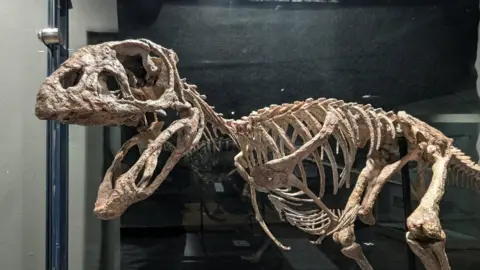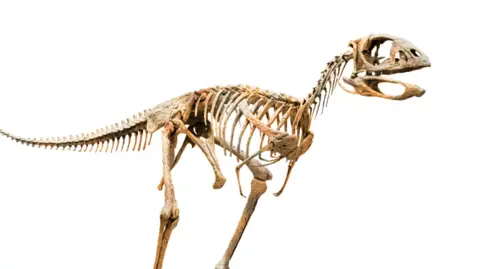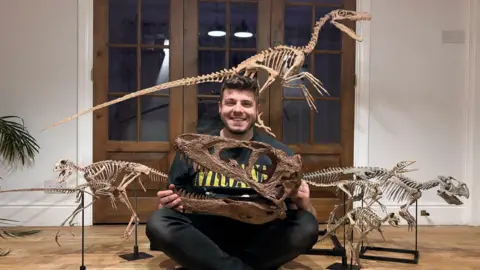Toothless dinosaur on display at museum
 Moyse's Hall Museum/West Suffolk Council
Moyse's Hall Museum/West Suffolk CouncilThe world's first accurate sculpture of a recently documented toothless dinosaur has gone on display.
Remains of the Berthasaura leopoldinae were first discovered in Brazil in 2012 and publicly revealed by scientists in 2021.
As part of a wider exhibition, West Suffolk Council's Moyse's Hall Museum in Bury St Edmunds, Suffolk, said it was now the first to display an accurate replica of the dinosaur's skeleton.
Alex Pritchard, 31, from Torquay, Devon is the sculptor and paleoartist behind the replica and said it had been a "bizarre" but "wonderful" feeling to know he was the first one in the world to bring it to life.
 Alex Pritchard
Alex Pritchard"It's a bit bizarre because when the paper was [published] they usually commission an artist to do a skeletal drawing and an illustrator to imagine what the dinosaur would look like, but no one had brought it into the 3D realm," he explained.
"So it's really weird bringing it to life because it's such a weird looking dinosaur that no one had seen... it's a really bizarre feeling, but wonderful at the same time."
 Alex Pritchard
Alex PritchardScientists believe the Berthasaura leopoldinae lived approximately 80 to 70 million years ago and was part of the Ceratosauria lineage.
It is considered to be unique due to being toothless and having a parrot-like beak, despite its carnivore-shaped body.
"It was discovered in 2012, but it takes a long time to do what they call a description where they study every bone they have found to try and piece together what type of animal it was and how it lived," Mr Pritchard continued.
"Once they've got enough information they can go to the scientific community, release a paper and say, 'We have discovered a new animal, we've discovered all these things about it, and this is why it is different from other things'."
 Alex Pritchard
Alex PritchardMr Pritchard explained he made use of the research papers to recreate the dinosaur which was time-consuming to ensure it was correct.
As well as this, not all parts of the dinosaur had been found, so Mr Pritchard had to look at papers for other dinosaurs and animals scientists believe were related to it.
The dinosaur features as part of the museum's Prehistoric Beasts: Land, Sea, Sky exhibition which is running until October.
Mr Pritchard is also donating another replica of the dinosaur to a Brazilian museum that was involved in the discovery of it but later burnt down.
Follow Suffolk news on BBC Sounds, Facebook, Instagram and X.
